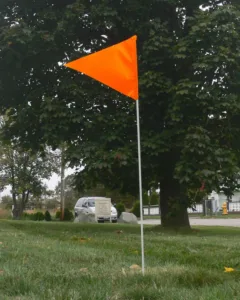Introduction
When it comes to outdoor applications, the choice of materials can significantly impact the efficiency, durability, and cost-effectiveness of your projects. Stake flags, commonly used in surveying, construction, and landscaping, are crucial for marking territories and ensuring areas are well-demarcated. This article explores two popular materials used in stake flags—fiberglass and metal—detailing their pros, cons, and best use scenarios to help you make an informed decision.

fiberglass stake flags
What are Fiberglass Stake Flags?
Fiberglass stake flags consist of a fiberglass post attached to a flag made of weather-resistant material. Known for their flexibility and strength, these flags are a favorite in areas with harsh weather conditions due to their ability to bend without breaking.
What are Metal Stake Flags?
Metal stake flags typically use steel or aluminum poles and are revered for their durability and rigidity. These flags are often employed in environments where a sturdy, permanent marker is necessary.
Durability and Weather Resistance
Fiberglass flags excel in environments that experience high winds and frequent weather changes. Unlike metal, fiberglass does not corrode or rust, making it ideal for wet climates. Conversely, metal stake flags offer superior durability in environments where structural integrity is paramount but may suffer from oxidation or corrosion if not properly treated.
Cost Comparison
From an initial cost perspective, metal stake flags can be more expensive than fiberglass due to the costs of raw materials. However, the longevity and minimal maintenance of metal can offset the initial investment, especially in environments less prone to corrosive elements.
Ease of Use and Installation
Fiberglass stake flags are lighter and easier to handle, making installation quick and reducing labor costs. Metal flags, though heavier, provide a more permanent solution and are less likely to be displaced by animals or human activities.
Visibility and Aesthetic Appeal
Both types of flags offer various colors for high visibility; however, fiberglass flags might fade slower due to their resistance to sun exposure. Metal flags can retain color better in shaded areas but may lose their aesthetic appeal faster in sunny conditions.
Maintenance and Care
Fiberglass requires little maintenance beyond occasional cleaning. Metal, while sturdy, may need regular treatments to prevent rust and maintain structural integrity.
Environmental Considerations
Fiberglass is non-conductive, making it safer around electrical installations. However, both materials have environmental impacts, primarily through the energy consumed during their production and eventual disposal issues.
Safety Concerns
Safety is paramount with stake flags. Fiberglass offers reduced risk of injury due to its flexibility, whereas metal, though potentially more hazardous due to sharp edges or rust, provides robust performance in high-traffic areas.
Lifespan and Durability
The lifespan of a stake flag greatly depends on the material and the environment. Fiberglass flags often outlast metal in corrosive environments but might not hold up as well under physical stress.
Pros and Cons of Fiberglass Stake Flags
Advantages:
- Cost-effective
- Flexible and less likely to cause injury
- Resistant to corrosion and environmental degradation
Disadvantages:
- Less stable in very high-traffic areas
- May bend or snap under extreme stress
Pros and Cons of Metal Stake Flags
Advantages:
- Extremely durable and stable
- Suitable for permanent installations
Disadvantages:
- Prone to rust and corrosion
- Higher initial cost and maintenance
User Reviews and Experiences
Field testimonials highlight the reliability of metal in permanent installations and the adaptability of fiberglass in dynamic environments. Each material has staunch supporters depending on specific needs and experiences.
Expert Recommendations
Experts in surveying and construction often recommend choosing the material based on specific project requirements, such as environmental conditions and budget constraints.
Comparative Analysis Summary
This head-to-head comparison underscores that the choice between fiberglass and metal stake flags should be guided by specific project needs, environmental factors, and budget considerations.
Conclusion
Choosing between fiberglass and metal stake flags involves weighing factors such as durability, cost, environmental impact, and specific project needs. Both materials have distinct advantages and limitations, making them suitable for different scenarios. By considering the comprehensive insights provided, you can select the most appropriate material for your outdoor use, ensuring both efficiency and longevity.
 info@unicomposite.com
info@unicomposite.com


























